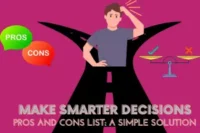Mastering Habit Change: Proven Strategies to Break and Replace Bad Habits
Published: 10/06/2025
Habits are the invisible forces shaping our lives—often without us even realizing it. From the moment we wake up in the morning to the time we go to bed, our habits determine how we spend our time, how we feel, and even how successful we are. The power of habits lies not only in their ability to make us more productive but also in their potential to transform our lives—either for the better or, if left unchecked, for the worse.
We all have bad habits—those little actions or thought patterns that, over time, create friction in our lives, hold us back, and leave us feeling stuck. Whether it’s procrastination, unhealthy eating, or constantly checking our phones, bad habits can prevent us from reaching our full potential.
The good news is, breaking bad habits and replacing them with positive ones is absolutely possible, and it all starts with understanding the science behind habits and how we can use that knowledge to our advantage.
This post will guide you through proven strategies to break free from bad habits, replace them with better behaviors, and create lasting changes that align with the life you truly want. You’ll learn how to identify the habits holding you back, how to harness the power of self-awareness, and how to design your environment and mindset for success.
But it’s not just about knowing what to do—it’s about doing it. We’ll dive into actionable tips and techniques that will empower you to take control of your habits, create positive change, and transform your life—one habit at a time.
Let’s explore the path to lasting change and how you can harness the power of habits to unlock a brighter, healthier, and more fulfilling future.
Understanding the Science of Habits: Beyond the Habit Loop
Habits are more than just actions we do without thinking—they’re deeply wired into our brain. To truly understand how to change bad habits, we need to dive into the science behind how habits form in the first place. It’s not just about willpower or motivation; it’s about the way our brain processes habits, making them automatic and sometimes hard to break. Let’s break it down.
The Habit Loop: Cue, Routine, Reward
At the core of any habit is the habit loop—a simple cycle that your brain follows over and over. This loop involves three key steps:
- Cue: This is the trigger, the event or feeling that sets the habit into motion. For example, feeling stressed might be the cue for reaching for a chocolate bar.
- Routine: This is the behavior or action you take in response to the cue. In the example above, the routine would be eating the chocolate.
- Reward: After completing the routine, you experience a reward—something that feels good. This could be the temporary relief of stress from eating the chocolate.
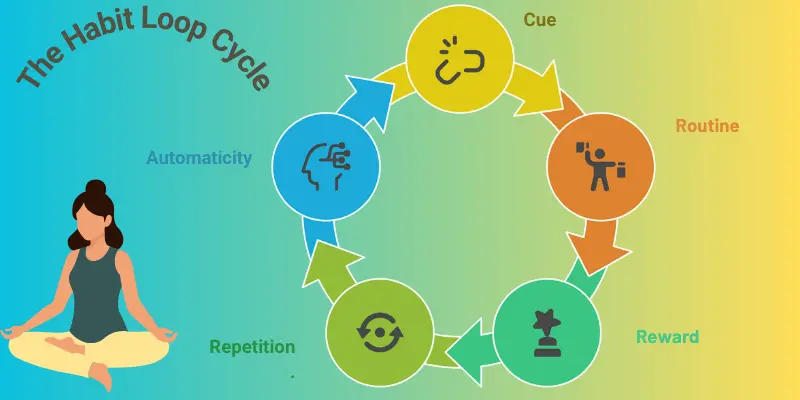
Over time, your brain starts associating the cue with the reward. That’s when the habit becomes automatic. This is why habits can be so hard to change—they’re ingrained in the brain’s wiring.
The Role of Repetition and Reinforcement
Now, here’s where things get interesting. Repetition is a huge factor in making a habit stick. Each time you go through the habit loop, your brain reinforces the connection between the cue, routine, and reward. The more often you repeat the loop, the stronger the neural pathways become.
For example, if you always eat chocolate when stressed, the loop becomes stronger. Over time, you’ll find yourself reaching for that chocolate almost automatically, without even thinking about it. The key here is that repetition reinforces the habit, making it harder to break.
Neural Pathways and Automaticity
The more we repeat an action, the more our brain creates neural pathways that make the action automatic. This means the more you do something, the less effort it takes. Your brain doesn’t need to “think” about the habit anymore—it just happens, almost without you realizing it.
This automaticity is what makes habits both helpful and harmful. Good habits, like brushing your teeth every morning, are automatic, which makes them easy to keep up. But the same process works for bad habits, too. The more you engage in a habit, the more it becomes automatic, which is why breaking bad habits can feel so challenging.
You do not rise to the level of your goals. You fall to the level of your systems James Clear, Author of Atomic Habits
Identifying Your Bad Habits: Self-Awareness is Key
Before you can start replacing bad habits, you need to become aware of them. It might sound simple, but many of us go through life on autopilot, unaware of the habits that are holding us back. Developing self-awareness is the first step in taking control and making meaningful changes.
Recognizing the Signs: Disruption, Exhaustion, Decreased Satisfaction, Avoidance
The first step in identifying a bad habit is noticing when it starts to disrupt your life. A bad habit often causes negative consequences, even if it feels good in the moment. Here are some common signs that a habit might be affecting you in ways you don’t realize:
- Disruption: If a habit is interfering with your responsibilities, relationships, or goals, it’s a clear sign it’s time for a change. For instance, procrastination might disrupt your productivity, causing you stress and last-minute panic.
- Exhaustion: Bad habits often leave us feeling drained rather than energized. If a habit (like binge-watching TV late at night) leads to poor sleep, you might feel tired the next day, impacting your overall well-being.
- Decreased Satisfaction: Over time, habits that initially gave us pleasure might lose their appeal. If eating junk food no longer gives you the satisfaction it once did, yet you still reach for it, that’s a sign your brain is stuck in an automatic loop.
- Avoidance: Bad habits can also be a form of avoidance. If you’re using habits to escape from stress or difficult emotions (like turning to social media instead of dealing with your feelings), that’s another red flag.
These signs are often the first indicators that a habit has become unhealthy and is no longer serving you.
Mapping Your Habit Loops: Triggers, Behaviors, Rewards
Once you start recognizing these signs, it’s time to get more specific. Mapping your habit loops can help you understand why certain habits keep repeating. The habit loop consists of three parts:
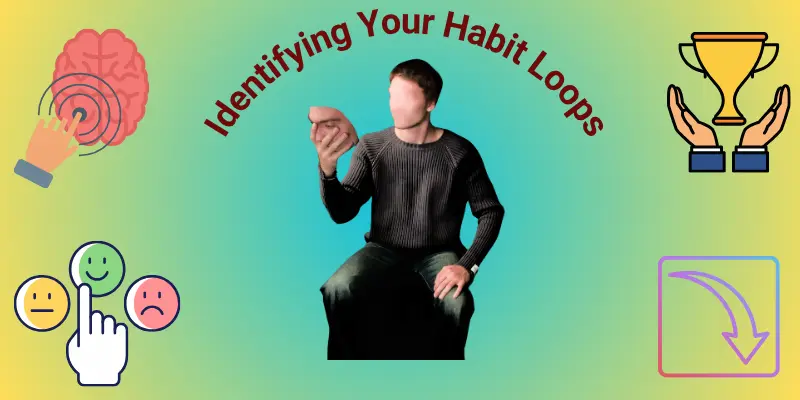
- Trigger (Cue): What sets off the habit? Is it a specific situation, emotion, or environment? Identifying your triggers will help you understand the “why” behind your behavior.
- Behavior (Routine): What do you do once the trigger occurs? This is the habit itself. For example, if stress is the trigger, maybe your routine is eating junk food or procrastinating.
- Reward: Every habit has a payoff. What’s the reward you get from the behavior? It could be temporary relief from stress, a moment of comfort, or even just the satisfaction of finishing a task in the case of procrastination.
Mapping out these three components can help you visualize your habits and see where they might be going wrong. Once you know the pattern, you can start working on breaking it.
The Importance of Self-Reflection and Journaling
Self-reflection is a powerful tool in habit change. By reflecting on your habits, you gain deeper insight into your triggers, emotions, and the consequences of your actions. One great way to do this is through journaling.
When you journal about your habits, ask yourself questions like:
- What triggers this habit?
- How do I feel before, during, and after performing this habit?
- What’s the payoff or reward I’m getting from this habit?
- How does this habit impact my life, my energy, my relationships?
Writing down your thoughts can help you spot patterns and connect the dots between your feelings, actions, and outcomes. It’s a powerful way to increase self-awareness and make conscious changes.
The Core Strategy: Replace, Don’t Just Remove
When it comes to breaking bad habits, one common mistake is focusing solely on eliminating them. While it may seem like the goal is to just get rid of a bad habit, research shows that replacement is a far more effective approach. Here’s why.
Why Replacement is More Effective than Elimination
Simply trying to remove a bad habit leaves a void—a gap in your routine. When we remove something without replacing it, our brains often fall back into old patterns to fill that void. This is why elimination alone doesn’t work for long-term change. It’s like trying to quit eating junk food but not replacing it with anything healthier. Eventually, you’ll find yourself reaching for the unhealthy snacks again.
On the other hand, replacing a bad habit with a positive one fills that gap with something productive, reinforcing new behaviors. The key to lasting change is about creating new patterns that not only replace the old ones but also lead to better rewards. By introducing a new habit, you make it easier to shift away from the old one while improving your overall lifestyle.
The Concept of Habit Stacking: Leveraging Existing Routines
One powerful tool for replacing bad habits is habit stacking. Habit stacking is the practice of attaching a new habit to an already established one. Instead of trying to force a new routine in isolation, you “stack” it onto something you already do automatically. This strategy leverages existing routines to help make new habits stick.
For example, if you already have a habit of having coffee every morning, you can stack a new habit on top of it. You could decide that after making your coffee, you’ll spend five minutes journaling or stretching. By linking the new habit to something you already do every day, you’re more likely to follow through with it consistently.
Practical Steps for Habit Stacking (with Examples)
Here are some simple steps to help you get started with habit stacking:
- Identify a Consistent Habit: Find something you already do regularly, like brushing your teeth, having lunch, or even walking the dog.
- Choose Your New Habit: Pick a small habit that you want to introduce—something easy to do and not too overwhelming. For example, taking a few deep breaths, doing a quick workout, or writing down one thing you’re grateful for.
- Link Them Together: Stack your new habit onto your existing one. For example, “After brushing my teeth in the morning, I will meditate for two minutes.” The idea is that the action of brushing your teeth will remind you to meditate.
- Keep It Simple and Start Small: Start with something small that’s easy to accomplish. Don’t try to overhaul your entire routine all at once. For example, don’t aim to meditate for an hour right away. Start with two minutes and build it up over time.
- Track Your Progress: Keep track of your habit stacking efforts in a journal or use a habit-tracking app. This helps you stay motivated and see your progress over time.
Example 1: Replace Snacking with Healthy Habits
If you’re trying to quit snacking on unhealthy foods in the evening, you could stack a new habit, like drinking a glass of water or having a healthy snack (like nuts or fruits) immediately after you sit down to watch your favorite TV show. Over time, this new routine will become just as automatic as the old habit of snacking.
Example 2: Add Movement to Your Day
Let’s say you’re trying to get more active. After you sit down for lunch, you could take a 5-minute walk around the block. This way, you’re stacking a new activity onto something you’re already doing, making it easier to commit to daily movement.
Proven Strategies for Breaking Bad Habits and Building New Ones
Now that we understand the science behind habits and how to replace them, it’s time to put it all into action. Breaking bad habits isn’t always easy, but with the right strategies, you can make the process smoother and more manageable. Let’s dive into some proven strategies to help you build positive habits while breaking the negative ones.
Strategy 1: Environmental Design (Make Good Habits Easy, Bad Habits Hard)
One of the most powerful ways to break bad habits and create new ones is to design your environment in a way that supports your goals. The idea is simple: Make good habits easy and bad habits hard.
Your environment plays a huge role in your behavior. If your surroundings are set up to support your bad habits, they’ll be harder to break. However, by making small changes to your environment, you can set yourself up for success and make it easier to stick to the good habits you want to form.

Removing Triggers
Triggers are the cues that prompt your habits, and they’re often right in front of you. For example, if you’re trying to break the habit of checking your phone first thing in the morning, consider removing your phone from your bedroom or placing it out of reach when you wake up.
The goal here is to remove the things that trigger bad habits. If you want to quit snacking late at night, don’t keep junk food in your kitchen. The less you have to fight against external triggers, the easier it becomes to stay on track.
Increasing Friction for Bad Habits
On the flip side, you can make bad habits harder to do by increasing friction. This means making the bad behavior more inconvenient, so you’re less likely to engage in it.
For example:
- If you want to stop mindlessly scrolling on your phone, consider deleting apps that distract you or using an app that blocks access to them after a certain time.
- If you want to cut back on TV, unplug the remote or put the TV in a less accessible area of the room.
The idea is that if it’s harder to perform a bad habit, you’ll be less likely to follow through with it. When there’s more effort required, it forces you to think twice before acting.
Setting Up for Success
Success doesn’t just happen; it’s something you have to set yourself up for. This means preparing your environment in a way that supports the habits you want to build. Here’s how:
- Prepare ahead of time: If you want to start working out in the morning, lay out your gym clothes the night before. This small change will make it easier to follow through with your workout because you’ve removed the friction of having to think about what to wear.
- Surround yourself with positive cues: Put healthy snacks like fruits or nuts in visible places, so you’re reminded of them throughout the day. Having things like these right in front of you makes it more likely you’ll reach for them instead of unhealthy options.
- Create a space for your good habits: If you’re working on writing more, create a dedicated space for it—one that is free of distractions and makes it easy to sit down and get started.
Strategy 2: Mindfulness and Awareness (The Power of the Pause)
Mindfulness is one of the most powerful tools you can use to break bad habits and build new, healthier ones. At its core, mindfulness is about being aware of what’s happening in the present moment, without judgment. By developing a mindful approach to your habits, you can break free from automatic responses and gain control over your actions. Let’s explore how mindfulness can play a crucial role in habit change.
Observing Cravings and Urges Without Acting
One of the biggest challenges in breaking bad habits is dealing with cravings and urges. These are the moments when your brain is wired to seek instant gratification, like when you’re craving that sugary snack or the urge to skip a workout.
Mindfulness teaches you to observe these cravings and urges without reacting to them. Instead of immediately giving in, you pause and acknowledge the feeling. You recognize that it’s just a passing thought or emotion, not something that must dictate your actions. This moment of awareness creates a space where you can make a conscious choice.
For example, when you feel the urge to check your phone, instead of grabbing it right away, take a breath and pause. Notice how you feel in that moment—perhaps a little anxious, bored, or distracted. Instead of automatically reaching for your phone, you can decide to take a deep breath or shift your focus to something else.
This pause, even if brief, gives you the power to choose whether to act on the urge or let it pass. Over time, this helps reduce the automaticity of your habits.
Mindful Meditation and Its Role
Mindful meditation is a great way to strengthen your ability to observe your thoughts and emotions without being controlled by them. Practicing mindfulness through meditation helps you become more aware of your patterns and reactions, making it easier to apply mindfulness when it matters most—during those critical moments when you’re tempted to fall back into old habits.

A few minutes of mindful meditation each day can train your mind to stay focused and calm in the face of cravings or urges. The more you practice, the better you get at observing your thoughts without automatically acting on them. This leads to greater self-control and a reduced tendency to act impulsively.
You don’t need to meditate for hours on end. Even just 5-10 minutes a day can be incredibly effective. Start by focusing on your breath, noticing the sensations in your body, or paying attention to your thoughts without judgment. This practice helps you become more present, reducing the likelihood of mindlessly engaging in a bad habit.
Creating a Gap Between Stimulus and Response
The key to breaking any habit lies in creating a gap between stimulus and response. A stimulus is any trigger that prompts a habit (like stress, boredom, or seeing your favorite snack), and your response is the automatic action that follows (like reaching for the snack or avoiding a task). Mindfulness helps create that gap by allowing you to pause and choose your response.
For example, if stress is your trigger to eat junk food, mindfulness gives you the space to pause and notice the stress without immediately reacting. You might recognize that you’re stressed, but instead of automatically reaching for food, you can choose a different response—like taking a few deep breaths, going for a walk, or doing something relaxing to address the stress.
The power of this pause lies in the control it gives you over your actions. By creating a space between stimulus and response, you’re no longer at the mercy of your automatic habits. You can break the cycle and make conscious decisions that serve your long-term well-being.
Strategy 3: Goal Setting and Motivation (The “Why” Behind the Change)
Changing habits requires more than just willpower—it requires motivation. But not all motivation is created equal. To make lasting changes, it’s important to understand why you want to break a bad habit in the first place. By setting clear goals and tapping into the right kind of motivation, you can stay on track and move closer to your desired outcome.
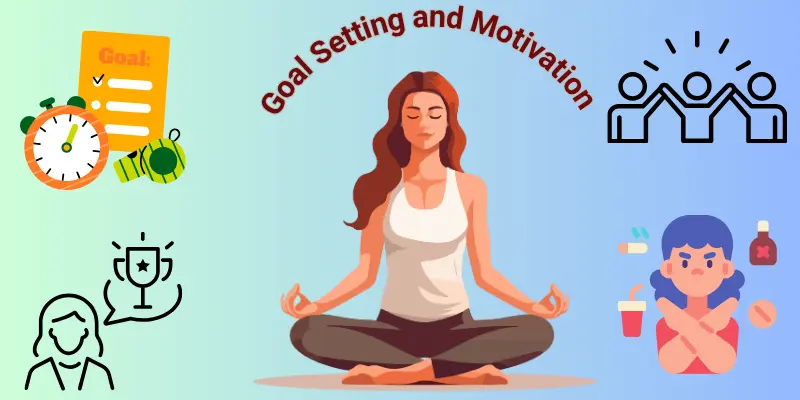
Defining Your “Why”: Intrinsic vs. Extrinsic Motivation
Before you start setting goals, it’s essential to get clear on why you want to make a change. There are two main types of motivation that influence our behavior: intrinsic and extrinsic.
- Intrinsic Motivation: This comes from within. It’s the drive to do something because it brings you personal satisfaction, joy, or fulfillment. For example, you might want to exercise because it makes you feel healthier and more energetic. Intrinsic motivation is often stronger and more sustainable because it’s tied to your personal values and long-term well-being.
- Extrinsic Motivation: This comes from external factors, like rewards or the desire to meet others’ expectations. For instance, you might exercise because you want to look a certain way for a special event or to meet a goal set by someone else. While extrinsic motivation can provide a short-term boost, it’s often less powerful than intrinsic motivation in creating lasting change.
To build habits that stick, it’s important to connect with your intrinsic motivation—the deeper reasons why you want to improve your life. Understanding this “why” will make it easier to stay committed when things get tough.
Setting SMART Goals for Habit Change
Once you’ve defined your “why,” it’s time to set goals that will help you achieve your desired habit change. One of the most effective methods for setting goals is the SMART framework. SMART stands for:
- Specific: Your goal should be clear and focused. Instead of saying, “I want to get fit,” try something like, “I want to work out three times a week for 30 minutes.”
- Measurable: You should be able to track your progress. For example, “I want to walk 10,000 steps every day” gives you a measurable goal to aim for.
- Achievable: Set goals that are realistic and within your ability. If you’re new to exercise, it might be unrealistic to aim for an hour at the gym every day. Start small and build up.
- Relevant: Your goal should align with your values and your “why.” If health is important to you, then a goal like “improve my diet” is relevant to your long-term well-being.
- Time-bound: Set a deadline or time frame for your goal. Instead of “I want to lose weight,” aim for something like, “I want to lose 5 pounds in the next 4 weeks.”
By setting SMART goals, you break down your big goals into smaller, more achievable steps. This makes the process less overwhelming and increases your chances of success.
Visualizing Success and Its Impact
Visualization is a powerful tool for habit change. By imagining yourself achieving your goals and experiencing the positive outcomes of your efforts, you strengthen your motivation and commitment.
Take a moment to visualize what success looks like for you. Close your eyes and picture yourself engaging in your new habit with ease. See yourself feeling healthier, more energized, or more confident. Imagine the benefits—whether it’s improved health, better productivity, or a sense of pride in your progress.
Visualization helps you connect emotionally to your goals, making the process feel more rewarding and motivating. It also boosts your confidence, as you start to believe that your success is possible.
Strategy 4: Social Support and Accountability (You Don’t Have to Do It Alone)
Changing habits can feel like a lonely journey, but the truth is, you don’t have to do it alone. Whether it’s a friend, family member, or a coach, having a support system can make a world of difference when trying to break bad habits and build new ones. Let’s dive into how social support and accountability can significantly boost your chances of success.
Finding a Support System (Friends, Family, Coach)
A support system plays a vital role in habit change. When you’re trying to make a change, it’s easy to slip back into old patterns. Having people around you who support your goals can help you stay motivated and on track.
- Friends and Family: Having friends or family members who understand your goals can be incredibly helpful. They can cheer you on, encourage you during tough times, and even help you stay accountable. For example, if you’re trying to stop smoking, having a family member or friend check in on your progress regularly can help you stay committed.
- Coaches or Mentors: If you want extra guidance, consider working with a coach or mentor. A coach can offer expert advice, provide structure, and help you navigate any challenges you face. They can be a great source of motivation and ensure you’re staying on track toward your goals.
It’s important to choose people who will encourage and empower you, not those who may be critical or dismissive of your efforts. A positive, supportive network can make a huge difference in your success.
The Benefits of Accountability Partners
An accountability partner is someone who checks in with you regularly, ensuring that you’re staying on track with your goals. This person doesn’t just provide moral support—they hold you accountable for your actions.
The benefits of having an accountability partner include:
- Increased motivation: Knowing that someone is checking in on your progress can be a powerful motivator to keep going, even when you don’t feel like it.
- Reduced procrastination: It’s easier to stay committed when you know you have someone waiting for you to show up or report back.
- Emotional support: When you hit a roadblock or feel discouraged, an accountability partner can offer encouragement and perspective.
For example, if you’re trying to exercise more, your accountability partner might be someone who joins you for workouts or simply checks in to see if you’ve completed your exercise for the day.
Joining Communities or Groups
In addition to one-on-one support, joining a community or group can provide you with a broader sense of connection and motivation. Communities can offer shared experiences, group support, and a sense of belonging, which can make the habit-changing process feel less isolating.
- Online communities: There are plenty of online groups, forums, or social media communities where you can find others who share similar goals. For example, joining a fitness group on Facebook or an online forum for people trying to quit smoking can provide a wealth of tips, support, and motivation.
- Local meetups or groups: You can also find local groups that meet regularly to support each other’s habits and goals. Whether it’s a workout group, a book club, or a sobriety support group, being part of a community that understands your journey can make all the difference.
Having a group to lean on during difficult times can help you stay focused and feel less alone in the process of change. Plus, communities often provide a space to celebrate wins, no matter how small.
Strategy 5: Gradual Reduction vs. Cold Turkey (Finding Your Pace)
When it comes to breaking bad habits, there’s no one-size-fits-all approach. For some, gradual reduction works best, while others may find success with a cold turkey approach. The key is to find your pace and choose the strategy that feels right for you. Let’s explore both options and how to make them work.
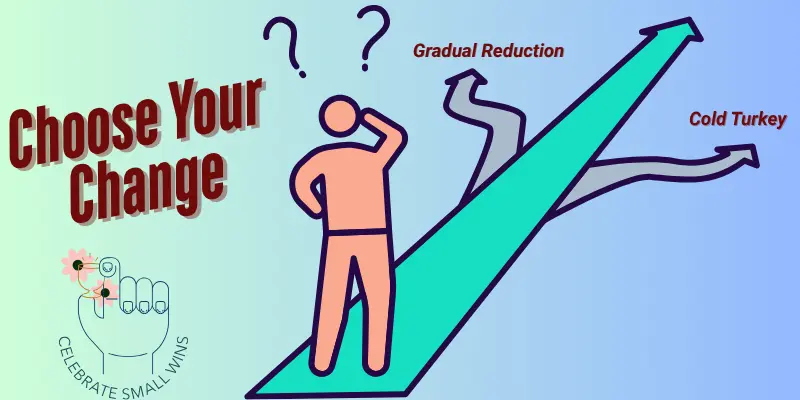
When Gradual Reduction is More Effective
Gradual reduction is often the best approach when you’re trying to break a habit that’s deeply ingrained or linked to strong emotional or physical triggers. This strategy involves slowly cutting back on the behavior over time, making the transition less overwhelming.
Here are a few situations where gradual reduction might be the way to go:
- Addiction or Dependency: If you’re trying to quit smoking or reduce alcohol consumption, quitting cold turkey can be intense and difficult. A gradual reduction allows you to taper off slowly, reducing withdrawal symptoms and making the process more manageable.
- Long-Standing Habits: For habits that have been part of your routine for years, going cold turkey might feel too drastic. For instance, if you’ve been eating junk food regularly for a long time, simply cutting it out all at once can leave you feeling deprived. Gradual reduction, such as replacing unhealthy snacks with healthier alternatives over time, can help you ease into a new, better routine.
- Reducing Stress-Induced Habits: If your habit is tied to managing stress (like binge eating or stress shopping), slowly finding new, healthier coping mechanisms can prevent you from feeling overwhelmed by making too many changes at once.
The key here is to set small, achievable milestones. Start by reducing your behavior incrementally and celebrate your progress along the way.
When Cold Turkey Might Work (and Its Risks)
Going cold turkey means quitting the habit completely and abruptly. This strategy can be effective for some people, especially when the habit is easier to quit or doesn’t have strong emotional or physical dependencies.
Here are situations where cold turkey might work:
- Short-Term, Less Addictive Habits: If you’re trying to break a habit that’s not deeply ingrained or not tied to addiction (like cutting back on screen time or stopping a certain type of procrastination), cold turkey can help reset your behavior quickly and effectively.
- A Fresh Start: Sometimes, making a complete break from a habit can feel empowering. If you’ve already tried to reduce the behavior gradually and found it didn’t work, going cold turkey might give you the clean break you need to get back on track.
However, cold turkey comes with risks, especially if the habit is deeply ingrained. You might experience intense cravings, emotional stress, or feelings of deprivation. If you don’t have a plan in place for coping with the challenges that arise, you could find yourself falling back into the old habit.
To make cold turkey work, be prepared for the mental and physical adjustments. It’s also crucial to have coping strategies in place, like mindfulness, journaling, or engaging in positive distractions, to help you through difficult moments.
Celebrating Small Wins Along the Way
No matter which approach you choose, celebrating small wins is essential for staying motivated. Whether you’re gradually reducing or going cold turkey, each step forward is progress. Acknowledging and celebrating these small victories helps keep your spirits high and reinforces the new behaviors you’re working to establish.
- If you’re gradually cutting down on sugar, celebrate the days you manage to avoid sugary snacks.
- If you’ve gone cold turkey on your phone habit, give yourself credit for every hour you stay off your device.
Remember, breaking a habit is a process, not an overnight transformation. The small wins add up, and they’re a crucial part of the journey. Celebrate them, and you’ll build momentum toward long-term success.
Strategy 6: Self-Compassion and Resilience (Bouncing Back from Setbacks)
The journey to breaking bad habits is rarely a straight path. Along the way, setbacks are bound to happen. What’s important is how you bounce back from these challenges. Self-compassion and resilience are key to staying on track, even when things don’t go as planned. Let’s explore how to recover from setbacks and keep moving forward.
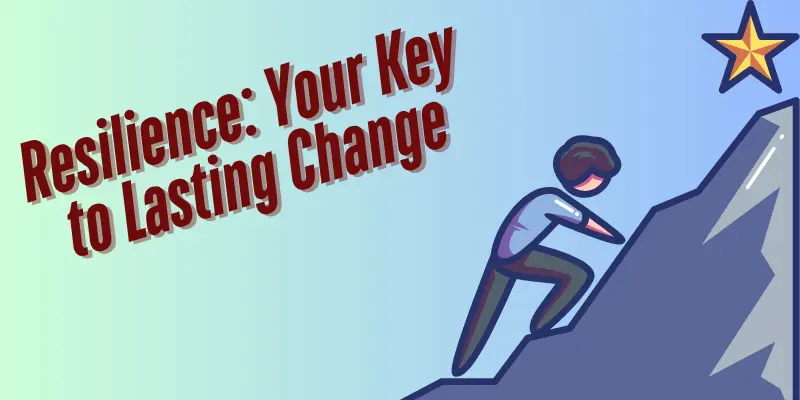
Understanding Lapses vs. Relapses
Before we dive into strategies for recovering from setbacks, it’s important to distinguish between lapses and relapses.
- Lapses: A lapse is a temporary slip-up, a momentary return to an old habit. Maybe you ate that slice of cake you were trying to avoid or skipped a workout after a long day. Lapses are normal and part of the process—what matters is that you recognize it, learn from it, and don’t let it derail your progress.
- Relapses: A relapse is a more prolonged return to old habits. It’s when you fall back into the habit for an extended period and might feel like you’ve completely lost control. While relapses can happen, they don’t define your journey. They simply signal that something needs to be reassessed and adjusted.
Understanding the difference between the two helps you avoid overreacting to a small setback. A lapse doesn’t mean you’ve failed; it’s just a temporary part of the process. A relapse, while more serious, can still be overcome with the right mindset and strategies.
Strategies for Recovering from a Slip-Up
When you experience a lapse, don’t be too hard on yourself. Here are some strategies for getting back on track:
- Acknowledge the Setback Without Judgment: The first step in recovery is acceptance. Recognize that setbacks happen to everyone and that this moment doesn’t define your success. Be kind to yourself and avoid self-criticism, which can lead to feelings of guilt or shame.
- Identify What Triggered the Slip-Up: Take a moment to reflect on what caused the lapse. Did you get stressed, tired, or distracted? Understanding the trigger helps you prepare for the next time it happens, so you can handle it differently.
- Get Back to Your Plan Immediately: Don’t wait until tomorrow or next week to restart. The sooner you get back on track, the easier it will be to maintain momentum. Whether it’s resuming your healthy eating plan or getting back into your exercise routine, acting quickly helps you regain control.
- Reach Out for Support: If you’re feeling down, reach out to your accountability partner or support system. Sharing your struggle with someone else can help you feel understood and motivated to keep going.
- Reflect and Learn: Every setback is an opportunity to learn. Use your lapse as a stepping stone for growth by identifying what worked and what didn’t. This reflection helps you fine-tune your strategy for long-term success.
The Importance of Self-Forgiveness
The most important element in bouncing back from setbacks is self-forgiveness. It’s easy to get discouraged when things don’t go as planned, but beating yourself up won’t help you achieve your goals.
Instead, practice self-compassion by forgiving yourself and recognizing that change takes time. We all make mistakes, and lapses are part of the journey. Treat yourself with the same kindness and patience you would offer to a friend who was facing a setback.
Self-forgiveness isn’t about excusing bad behavior—it’s about accepting that you’re human. It allows you to move forward without carrying emotional baggage, keeping you motivated and focused on your ultimate goal.
A moment of self-compassion can change your entire day. A string of such moments can change the course of your life.Kristin Neff, Pioneer in Self-Compassion Research
Maintaining Long-Term Change: Preventing Relapse and Sustaining Progress
Breaking a bad habit is one thing, but maintaining long-term change is a whole other challenge. The key to lasting transformation is to keep your progress steady and prevent relapse. Developing the right strategies to protect your hard-earned changes is crucial. Here’s how to keep moving forward and sustain your success.
Identifying High-Risk Situations and Developing Coping Mechanisms
Even after you’ve broken a bad habit, there will still be situations where you might feel tempted to fall back into old behaviors. High-risk situations are those moments or environments where you’re more vulnerable to slipping up. Identifying these situations ahead of time can help you prepare and protect your progress.
For example:
- If stress causes you to overeat, high-risk situations might include stressful work days or family conflicts.
- If you tend to procrastinate in the evening, a high-risk situation might be when you’re alone and feel unmotivated to get work done.
Once you’ve identified these situations, you can create coping mechanisms to help you navigate them. These could include:
- Stress management techniques like deep breathing, meditation, or taking a walk.
- Productivity hacks like setting a timer to stay focused or breaking tasks into smaller steps.
- Support systems like reaching out to a friend or accountability partner when you’re feeling tempted.
Building a Relapse Prevention Plan
A relapse prevention plan is a proactive way to protect your progress and ensure that you don’t fall back into old habits. This plan helps you stay focused on your goals, even during difficult times. Here’s how to build an effective relapse prevention plan:
- Identify Warning Signs: Recognize the behaviors, emotions, or situations that signal a potential relapse. Are you feeling overwhelmed, stressed, or disconnected? Spotting these signs early can help you address them before they lead to a setback.
- Develop Action Steps: Create a clear action plan for what you will do when you notice these warning signs. For instance, if you feel the urge to skip a workout, you could commit to a quick 10-minute session to keep your momentum going.
- Seek Support: Ensure that your support system is in place. Whether it’s through friends, family, or online communities, staying connected with people who encourage you can provide a lifeline during tough times.
- Revisit Your Goals: Occasionally reflect on why you’re making these changes in the first place. Revisiting your “why” strengthens your commitment and reminds you of the long-term benefits.
Having a relapse prevention plan doesn’t mean you’re expecting to fail—it’s about preparing yourself to stay resilient when challenges arise. It’s a proactive, empowered approach to protecting your progress.
Continuous Self-Assessment and Adjustment
Maintaining long-term change requires continuous self-assessment. Regularly checking in with yourself helps ensure that you’re staying on track and adapting your approach as needed. The process of habit change is dynamic, and your needs may evolve over time.
Here’s how to incorporate self-assessment into your routine:
- Track Your Progress: Keep a journal, use a habit tracker, or reflect on your journey regularly to monitor your progress. This helps you stay accountable and gives you the opportunity to celebrate your achievements.
- Evaluate Your Strategies: If something isn’t working, don’t be afraid to adjust your approach. Maybe a coping mechanism isn’t as effective as you thought, or perhaps a goal needs to be modified to make it more achievable.
- Check Your Emotions: Habits are often tied to emotions. Regularly ask yourself how you’re feeling and whether your habits align with your emotional needs. This helps you stay in touch with your motivations and make sure they’re still valid.
By assessing yourself regularly, you ensure that you’re not just maintaining progress but actively growing and improving.
The Role of Identity-Based Habits
One of the most powerful ways to sustain long-term change is to shift your identity. Instead of seeing your habit change as a short-term goal, think of it as part of who you are. When you align your habits with your identity, the changes become part of your core self.
For example:
- Instead of saying, “I want to exercise more,” reframe it to, “I am someone who enjoys being active.”
- Instead of saying, “I want to eat healthier,” try, “I am someone who values my health and makes nutritious choices.”
When you see yourself as the type of person who engages in positive behaviors, you’re more likely to stick with them. Identity-based habits are deeply tied to your values and beliefs, making them stronger and more lasting.
Advanced Techniques and Personalization
As you work on breaking bad habits and building new ones, it’s important to recognize that everyone’s journey is unique. What works for one person might not work for another. That’s where personalization comes in. By tailoring your strategies to fit your own tendencies and needs, you can enhance your chances of success. Let’s explore some advanced techniques to help you fine-tune your approach.
Understanding Your Tendencies (e.g., Gretchen Rubin’s Four Tendencies)
One of the best ways to personalize your habit-building strategies is by understanding your tendencies—the way you naturally respond to expectations, both from yourself and others. Gretchen Rubin, an expert on habit formation, outlines four personality types in her book Better Than Before. Knowing which tendency you fall into can help you choose the most effective strategies for habit change.
Here are the four tendencies:
- Upholders: Upholders meet both inner and outer expectations. They’re self-motivated and reliable, but can sometimes become rigid or overwhelmed by too many rules.
- Strategy: Upholders often benefit from clear goals and structure. They should aim to set boundaries for their habits and balance their routine without overloading themselves.
- Questioners: Questioners meet inner expectations but resist outer expectations unless they see a logical reason for them.
- Strategy: Questioners need to understand why a habit is important before they commit to it. They thrive when given detailed information and a clear rationale for change.
- Obligers: Obligers meet outer expectations but struggle with inner expectations. They might find it difficult to stick to personal goals unless there’s external accountability.
- Strategy: Obligers do well when they have someone holding them accountable. Setting up a support system or external deadlines is key for them to stay on track.
- Rebels: Rebels resist both inner and outer expectations. They prefer to act on their own terms and might resist imposed habits.
- Strategy: Rebels thrive on freedom. For them, framing habits as a choice rather than a rule, and giving them autonomy over how they do things, can help them stay committed.
By identifying which tendency best describes you, you can personalize your habit-changing strategies to work with your natural tendencies, making it easier to succeed.
Tailoring Strategies to Specific Habit Types (e.g., Emotional Eating, Procrastination, Screen Time)
Different habits require different approaches. Once you identify your tendency, it’s time to tailor your strategy to the specific type of habit you’re trying to change. Here are a few examples of how to adjust your approach for common habits:
- Emotional Eating: Emotional eating is often triggered by stress, sadness, or boredom. To break this habit, focus on identifying your emotional triggers and developing healthier coping strategies.
- Strategy: Practice mindfulness to recognize emotional cues without reacting impulsively. Replace eating with stress-relieving activities like walking, deep breathing, or journaling.
- Procrastination: Procrastination often happens because of perfectionism, fear of failure, or feeling overwhelmed by tasks.
- Strategy: Break tasks into smaller, manageable steps. Use time-blocking or the Pomodoro technique to stay focused. Pair the task with something enjoyable (e.g., listening to music) to make it more rewarding.
- Screen Time: Excessive screen time can be addictive and damaging to both mental health and productivity.
- Strategy: Set specific limits for screen time and stick to them. Use apps that track and limit usage, and designate “phone-free” times or zones in your home (e.g., no screens in the bedroom).
By tailoring your approach to these specific habits, you can create more effective strategies that address the root causes and help you achieve lasting change.
Leveraging Technology: Habit Trackers, Mindfulness Apps, etc.
In today’s digital world, technology can be a powerful ally in habit formation. There are many tools designed to help you track your progress, stay motivated, and build new habits more effectively. Here are a few options:
- Habit Trackers: Habit tracker apps (like Habitica, Streaks, or HabitBull) help you monitor your progress and stay consistent. By tracking your habits daily, you can see how far you’ve come and how consistent you’ve been, which is great for motivation.
- Mindfulness Apps: Apps like Headspace, Calm, or Insight Timer offer guided meditations and mindfulness exercises to help you manage stress and stay present. Mindfulness practices can be especially helpful for breaking habits like emotional eating or excessive screen time.
- Task Management Apps: Apps like Todoist or Trello help you stay organized and break tasks down into manageable steps, which is especially useful for combating procrastination. These apps can help you prioritize tasks and track your progress.
- Support and Accountability Apps: Some apps, like StickK, let you commit to goals and involve a third party to hold you accountable. Knowing someone is checking in on your progress can be a great motivator.
Leveraging these tools can help you stay focused, track your habits, and ensure that you remain on the path toward lasting change.
Conclusion: Your Journey to Lasting Habit Transformation
Changing habits is a process that takes time, effort, and commitment, but the rewards are well worth it. Whether you’re looking to break a bad habit or build a new, healthier one, the strategies we’ve covered will help you make lasting changes that truly improve your life. Remember, it’s not about perfection—it’s about progress. Here’s a quick recap of the key strategies that will guide you on your journey:
Recap of Key Strategies:
- Understanding the Science of Habits: Recognize the habit loop (cue, routine, reward) and understand how repetition strengthens neural pathways, making habits automatic. This awareness is the foundation for change.
- Identifying Your Bad Habits: Self-awareness is key. By recognizing the signs of bad habits and mapping your habit loops, you can better understand the triggers and rewards driving your behavior.
- Replace, Don’t Just Remove: Instead of simply eliminating a bad habit, replace it with a positive one. Use habit stacking to build on existing routines, making it easier to integrate new habits into your daily life.
- Social Support and Accountability: You don’t have to do it alone! Lean on friends, family, or accountability partners to stay motivated and committed to your goals.
- Gradual Reduction vs. Cold Turkey: Find your pace. Whether you choose a gradual reduction or go cold turkey, make sure your approach suits your needs and doesn’t overwhelm you.
- Self-Compassion and Resilience: Setbacks are part of the process. Practice self-compassion, forgive yourself for slip-ups, and bounce back stronger. Focus on the long-term goal, not the momentary stumble.
- Preventing Relapse: Identify high-risk situations and develop coping mechanisms. Create a relapse prevention plan and regularly assess your progress to ensure you’re staying on track.
- Personalization: Tailor your strategies to your personality and specific habits. Understanding your tendencies and leveraging technology like habit trackers or mindfulness apps can make the process easier and more effective.
The road to habit transformation isn’t always easy, but every step forward is a victory. Be patient with yourself—habit change is a journey, not a sprint. Remember, you don’t have to be perfect to succeed. Each time you slip up, just get back up, reflect, and continue moving forward. Celebrate your small wins and acknowledge your progress along the way. The fact that you’re reading this post means you’re already committed to making positive changes in your life, and that’s something to be proud of!
Start Your Habit Change Journey Today
It’s time to take action. Choose one habit you want to change, and begin applying the strategies outlined in this post. Whether you’re tackling emotional eating, overcoming procrastination, or simply trying to stay more organized, the best time to start is now. Don’t wait for the “perfect moment” to make a change—start today, even if it’s with small, simple steps.
Your future self will thank you for the effort you put in today. Remember, you’re capable of making lasting changes that lead to a healthier, happier life. Stay committed, stay resilient, and trust that the transformation is worth the effort.
Expert Insights: Tackling Your Toughest Habit Questions
The habit loop consists of three components: the cue (trigger), the routine (behavior), and the reward. Understanding this loop helps you identify and modify habits by disrupting the existing pattern and replacing it with a new, healthier routine.
Self-awareness allows you to recognize the triggers and rewards associated with your habits. By mapping out your habit loops and reflecting on your behaviors, you can identify areas for change and implement strategies to replace negative habits with positive ones.
Replacing a bad habit involves identifying a positive behavior that satisfies the same need or desire. For example, if stress leads you to overeat, consider replacing eating with a stress-relief activity like deep breathing or a short walk. This approach is often more sustainable than attempting to eliminate a habit without substitution.
Mindfulness helps you become aware of cravings and urges without acting on them impulsively. Practicing mindfulness through techniques like meditation can create a gap between stimulus and response, allowing you to make conscious choices rather than defaulting to old habits.
Setting SMART goals—Specific, Measurable, Achievable, Relevant, and Time-bound—provides clarity and direction. For instance, instead of saying, “I want to exercise more,” a SMART goal would be, “I will walk for 30 minutes every morning before work for the next month.
Absolutely. Having a support system, such as friends, family, or accountability partners, can provide encouragement and motivation. Sharing your goals with others can increase commitment and help you stay on track.
The approach depends on the habit and individual preferences. Gradual reduction can be effective for deeply ingrained habits, while going cold turkey might work for habits that are less entrenched. It’s important to choose a method that aligns with your personality and the nature of the habit.
Setbacks are a natural part of the habit-changing process. Instead of viewing them as failures, use them as learning opportunities. Reflect on what led to the setback, adjust your strategies if necessary, and continue moving forward with renewed determination.
Maintaining change involves continuous self-assessment and adjustment. Regularly evaluate your progress, identify high-risk situations, and develop coping mechanisms. Building identity-based habits—seeing yourself as someone who embodies the desired behavior—can also reinforce lasting change.
Yes, various tools can support habit formation. Habit trackers, mindfulness apps, and task management tools can help you monitor progress, stay organized, and maintain motivation. Selecting tools that align with your goals and preferences can enhance your habit-building efforts.

- Be Respectful
- Stay Relevant
- Stay Positive
- True Feedback
- Encourage Discussion
- Avoid Spamming
- No Fake News
- Don't Copy-Paste
- No Personal Attacks



- Be Respectful
- Stay Relevant
- Stay Positive
- True Feedback
- Encourage Discussion
- Avoid Spamming
- No Fake News
- Don't Copy-Paste
- No Personal Attacks




